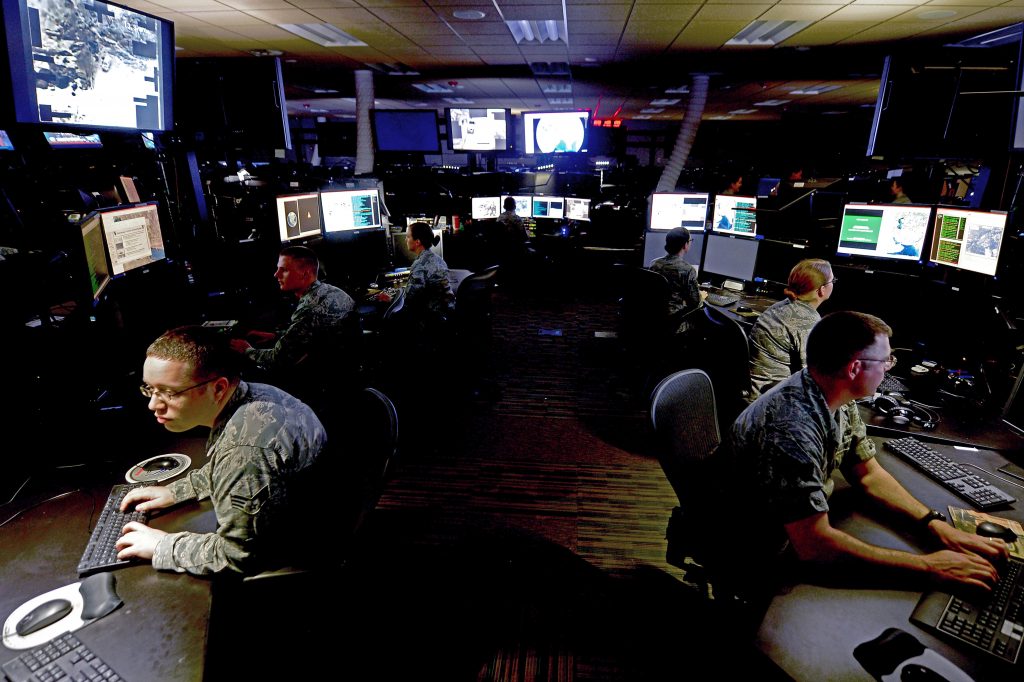"The major challenge for the US is China," CNA analyst Larry Lewis said. "They are approaching the use of AI just like the US approached going to the moon in the sixties."
The JAIC will report to Chief Information Officer Dana Deasy, the establishing memo by Deputy Defense Secretary Patrick Shanahan says. Its ambit is not quite untrammeled; any projects under $15 million remain the authority of the service or agency. The JAIC will establish a common set of AI “standards…. tools, shared data, reusable technology, processes, and expertise” for the whole Defense Department, according to the June 27 memo.
Undersecretary for Research & Engineering Mike Griffin, a far more prominent proponent of AI and other cutting-edge technologies who has warned China and Russia are catching up to the US, “will continue to promote development of new AI technologies, systems, and concepts” but without any clearly specified role in the new center.
Shanahan directs CIO Deasy to consult with the services, Joint Staff, combatant commands, and other DoD entities on the initial list of National Mission Initiatives. Those entities, in return, are to “coordinate” with the CIO on “each AI initiative that totals more than $15 million annually,” although that threshold “will be reviewed annually as investments in AI mature” — which presumably means it’ll go up as AI projects become more routine. (For scale, Google’s initial Project Maven contract was just $9 million, but the company projected it would swiftly grow to $15 million and ultimately $250 million).
JAIC will also coordinate with other government agencies, “industry, academics, and U.S. allies,” the memo says. UPDATE “Harnessing the strengths of industry and academia (is crucial) and that is explicitly called out,” said Larry Lewis, director of CNA’s Center for Autonomy and AI. “It’s not necessarily going to be easy, but including the discussion about ethics and AI safety (so prominently) is going to be an important piece of that.”

Finding The Missing Pieces
UPDATED “I’m very excited to hear about the stand up of the new JAIC,” said Bob Work, former deputy secretary of defense and one of the Pentagon’s foremost proponents of artificial intelligence. “The Defense Innovation Board recommended the Department create an AI Center of Excellence nearly a year and a half ago. Although I wish it had not taken this long to (create it), the JAIC is an important step forward in exploring and pushing AI and machine learning throughout the department, for both operational and business applications.”
“The JAIC’s initial funding is quite modest, and we have a
lot to learn about its mission and activities,” Work cautioned. “But
its standup is a welcome first step in response to Chinese, and to a
lesser extent, Russian, plans to dominate these technologies.”
“This is a big deal,” CNA’s Lewis agreed. “This is an acknowledgment that the US is in a new, competitive security environment and that AI is likely to be decisive.”“It gives organizational focus,” Lewis said of the JAIC. In Shanahan’s memo, “it talks about bringing to bear resources and expertise, and then it talks about providing foundational pieces that DoD is currently missing.”
“One of those is data processes, curating data,” Lewis continued “We have many systems out there that collect intelligence or collect surveillance, but we don’t necessarily keep it all, and we don’t necessarily have it in formats that can be easily exploited with machine learning” — indeed, many of the formats aren’t even compatible with each other — “so we have some foundational work to do to be able to bring all the data that we have to bear.” Massed data is critical because modern AIs refine their algorithms through machine learning, and the more data they have to go through, the better. (That’s assuming the data is not polluted by unintentional bias or deliberate disinformation).
Beyond creating a pool of data, the JAIC mission also includes creating common processes, technologies, and tools that all of DoD can draw on, as well as a central body of AI experts to consult with. “You don’t need everyone to be a PhD data science person,” Lewis said. “You have some experts that can develop algorithms, (but) you have to marry that technical expertise with people who understand (military) operations.”
That preserves a vital role for the four armed services. “This is not an overly centralized process,” Lewis said. “It (the memo) emphasizes several times this is in collaboration with the services…. It brings focus and it brings enablers that are then used by the different services.”
What’s not clear yet, Lewis said, is the role of the undersecretary for research and engineering, Mike Griffin. That’s something that the Pentagon will have to work out over time, perhaps as part of its forthcoming AI strategy.

Countering Russia, China
UPDATED How does JAIC compare to competitors’ efforts in AI? The Chinese government has officially made global dominance in AI a national priority, while Russia constantly touts its combat robots field-tested in Syria and elsewhere.
“Within the Russian Ministry of Defense, there are now two centers responsible for the development of the latest breakthrough technologies, such as autonomous weapons, but no specific agency-wide effort to develop AI center like JAIC,” said CNA scholar Sam Bendett, a close observer of Russian military technology. “On the other hand, the MOD has lots of AI and other high-tech R&D taking place amongst its numerous academic institutions, an effort that the MOD is keen on consolidating further.’
In fact, in a development strangely reminiscent of the Soviet era, the Russians are actually building a “city” on the Black Sea for AI and related research, with a planned population of at least 2,000 engineers and scientists by 2020. “Currently, lots of efforts are going towards the establishment and staffing of the Era ‘technopolis,'” said Bendett, “a 50-acre city with S&T and R&D centers/laboratories and living spaces for soldiers and private sector workers who will be developing numerous projects for the nation’s military, with a specific focus on AI, autonomy and big data analytics.”
The Russians are watching US developments closely and will probably react to JAIC’s creation with “a certain degree of apprehension,” Bendett told me, mainly because of how it might help the Pentagon tap into America’s massive private sector investment in artificial intelligence. “Currently, Russian AI funding is only a small fraction of what is spent in the US, or China, for that matter,” he said
“We do have a very strong commercial sector,” agreed fellow CNA analyst Larry Lewis, “but unlike China we are going to be more challenged to leverage that for national security, as we’ve seen with the example in Google.” Google’s decision to opt out of a military contract would simply be unthinkable for a Chinese company, he told me: “In China, you’re free to do business but if the government wants something of yours, it’s theirs.”
“At the highest levels, the Chinese government is
prioritizing and directing strong state support to AI development,
leveraging and harnessing the dynamism of the ‘national champions,’
including Baidu, Alibaba, and Tencent, that are at the forefront of
China’s AI revolution,” said CNAS scholar Elsa Kania.
“China’s approach might be characterized as state-driven but
market-centric, with an integrated approach (combing) academia, tech
companies, the defense industry, and the military…..a national strategy
of civil-military fusion.”
“For instance, Baidu is partnering with the CETC, a major
state-owned defense conglomerate, through the Joint Laboratory for
Intelligent Command and Control Technologies, which seeks to advance the
use of big data, artificial intelligence, and cloud computing for
military command and information systems,” Kania went on. “This spring,
the Chinese military launched what might be characterized as a would-be DIUx
with Chinese characteristics. This ‘rapid response team,’ launched in
Shenzhen, is intended to (enhance) the PLA’s capability to leverage
advanced commercial technologies for military purposes.”
So while the US has strong tradition of innovation, entrepreneurship,
and individual creativity, China is investing heavily in AI, its
capabilities are growing rapidly, and its government is systematically
tapping civilian innovation for military use. But that’s not all. “The
other strength that they have is they have lots and lots of data” to
train machine learning algorithms, Lewis noted. “China has many more
people, they don’t have privacy concerns, so they have advantages there
that we don’t have.”“The major challenge for the US is China,” Lewis said. “Not only do they have comparable capabilities in the commercial sector, which is really important, but….they have a national strategy. They are approaching the use of AI just like the US approached going to the moon in the sixties.”
The full memo is reproduced below.
Establishment of the Joint Artificial Intelligence Center OSD008412-18 R… by BreakingDefense on Scribd
ΠΗΓΗ








Δεν υπάρχουν σχόλια:
Δημοσίευση σχολίου